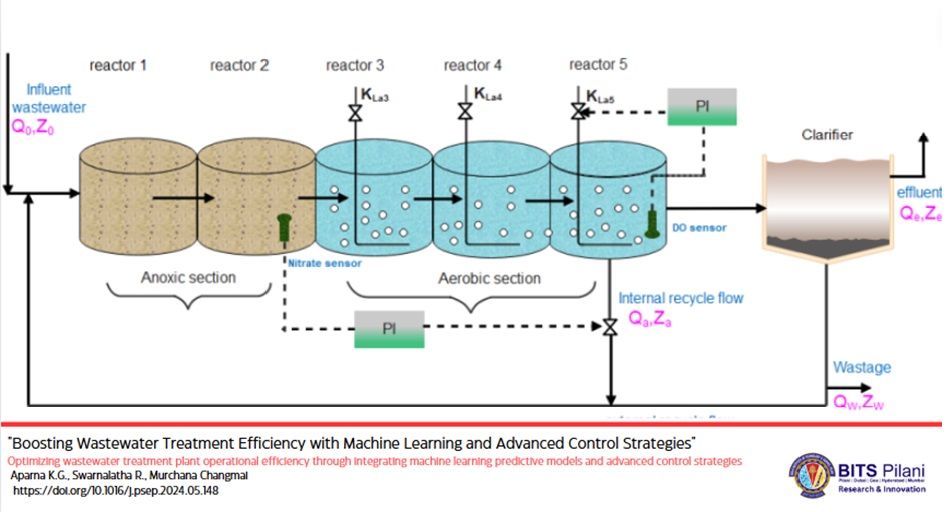
The researchers from BITS-Pilani, Dubai Campus are focusing on optimizing wastewater treatment plant (WWTP) operational efficiency by integrating advanced control strategies and predictive modeling using machine learning. Led by Dr. Swarnalatha R, Dr. Murchana Changmai and Ms Aparna KG, the team aims to accurately combine these control strategies to enhance efficiency and pollution regulation in WWTPs. Two control strategies were tested: a hybrid approach combining feedforward and feedback control and a self-organizing fuzzy inference system (SOFIS) control. The findings highlight the effectiveness of integrating machine learning techniques into WWTP control systems for optimizing pollutant regulation
Key Insights
- Predictive modeling Integration: Integrating predictive modeling techniques into WWTP control systems enhances operational parameters and overall efficiency.
- Hybrid Control Approach: The feedforward-feedback control approach improves compliance with regulatory standards and operational efficiency.
- Adaptive fuzzy control: The self-organizing fuzzy control system adaptively adjusts control parameters based on predicted effluent characteristics.
- Cost and Quality Improvement: Advanced control strategies in WWTP operations show promising results in improving effluent quality and minimizing operational costs.
This study utilizes Benchmark Simulation Model 1 (BSM1) to enhance WWTP operations through sophisticated control techniques and predictive modeling. By employing feature extraction methods (filter, wrapper, and embedded), robust prediction models were developed using the random forest (RF) algorithm to forecast effluent ammonia and nitrogen concentration. It is imperative to incorporate these predictive models into the control system of the WWTP in order to improve efficiency and regulate pollution. The two control strategies that were tested involved a hybrid approach, which combined feedforward and feedback control. This resulted in an enhanced effluent quality index (EQI), a slight increase in aeration energy (AE) and operational cost index (OCI), and a notable reduction in effluent ammonia concentration. The second technique employed the use of a self-organizing fuzzy inference system (SOFIS) control, which led to positive results by enhancing the EQI, reducing ammonia and nitrogen concentrations, and causing only minimal increases in AE and OCI. The SOFIS control method resulted in improvements of 2.18% in EQI, a 6% decrease in effluent ammonia concentration, and a 2.5% reduction in total nitrogen concentration, with minimal increases in AE (0.2%) and OCI (0.3%).
This research emphasizes the critical need for accurately forecasting wastewater effluent quality parameters and integrating these predictions into WWTP control systems. The results showcase the efficacy of this comprehensive approach in optimizing pollution regulation and enhancing overall system performance.
Moreover, this study offers valuable insights into the practical application of machine learning-based control techniques in wastewater treatment, highlighting potential opportunities for further investigation into sophisticated algorithms for operational WWTPs. The Graphical abstract given below summarizes the entire work, showcasing the integration of machine learning with control strategies for WWTP optimization.
In summary, this research demonstrates the effectiveness of incorporating machine learning techniques into the control strategies of wastewater treatment plants (WWTPs) to enhance the prediction of effluent concentrations. By utilizing advanced feature selection techniques, the study demonstrates how incorporating predictive models into wastewater treatment plant (WWTP) control systems can greatly enhance operational efficiency and bolster pollution management efforts in wastewater treatment processes.


 An Institute of Eminence
An Institute of Eminence








